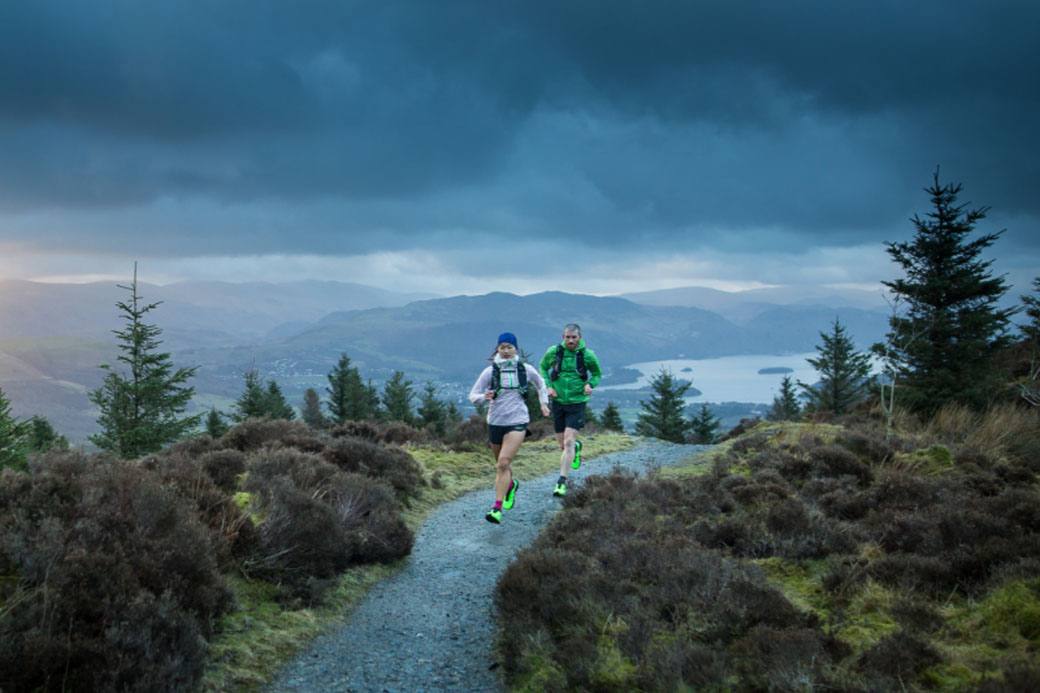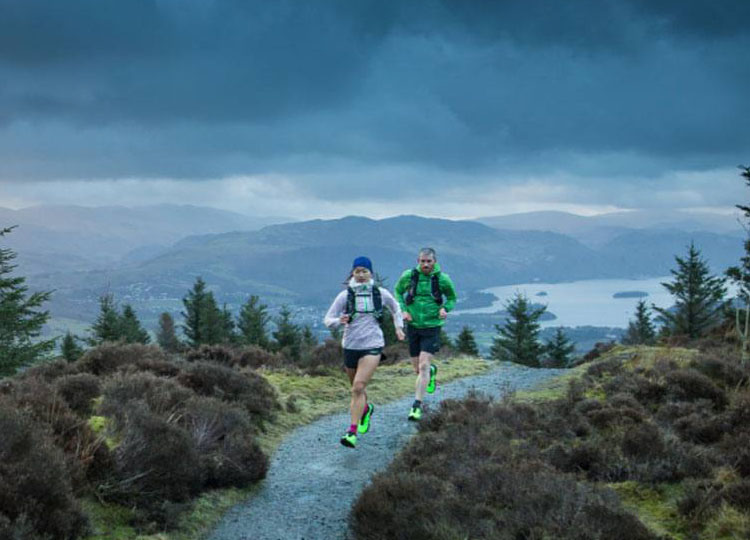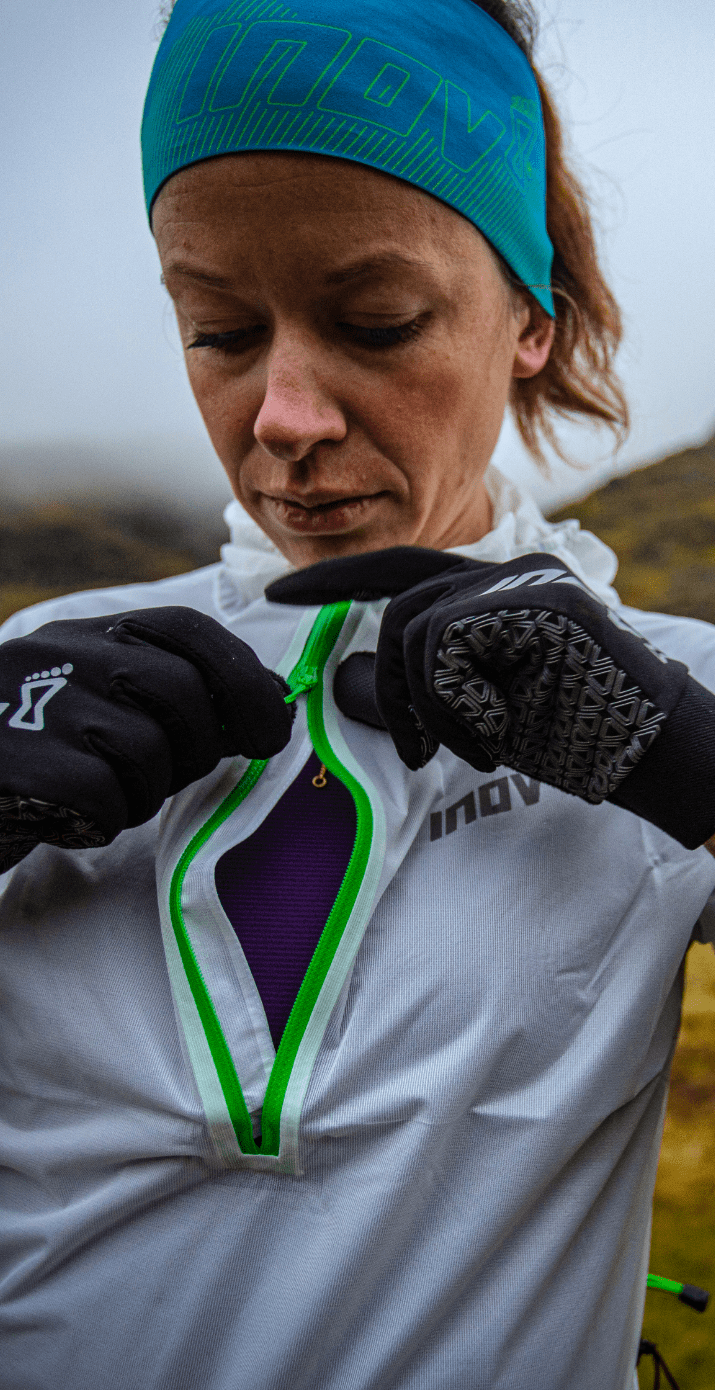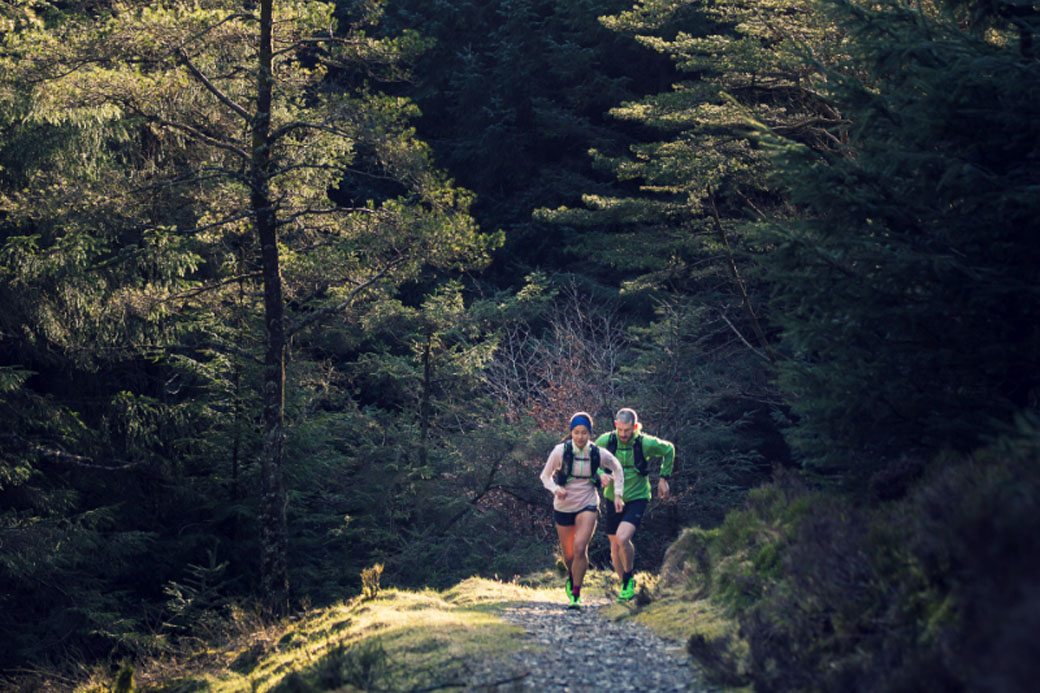
At only five miles longer than a marathon, a 50K race is a great introduction to ultra running. It’s a very achievable distance – particularly if you’ve run a 20 mile race or marathon previously.
Our 16-week 50K ultramarathon training plan has been written by Sarah McCormack, a qualified running coach and international ultrarunner. Sarah’s flexible and highly-adaptable plan will make sure you’re well prepared for your event (especially if it’s hilly!).
At the end of this guide, we have a list of a few of our favourite 50K(ish) ultras. These races vary in length, but most are within the 50-55K range. Bear in mind that depending on the event you choose, you may also need to build your confidence with night running and self-navigation too.
We hope you enjoy the training plan and that you have a great race!


Before you start
50K is a big distance to cover if you’ve not run long before. Of course, some people will enter a 50K having never run more than a 10K in the past, but in most cases this wouldn’t be advisable. Ideally, you’ll have raced a trail marathon or 20-miler previously before taking on this plan.
Sarah’s training plan is based on someone who is already running five or six days a week, accumulating an average weekly mileage of at least 30-40 miles. However, the plan can easily be modified to five days of running per week by skipping the Saturday or Thursday easy runs.
Sudden jumps in mileage, speedwork or elevation are a recipe for sore legs and injury. If week one would be too much of a stretch for you from where you currently are, consider:
- Substituting the Saturday or Thursday easy run and/or one of the hard sessions for rest days
- Substituting one of the hard sessions for an easy run for a few weeks. Then gradually increase the speedwork over a number of weeks (particularly if you currently only do one hard session per week). If you drop one of the hard sessions, be sure to alternate the type of workout (don’t miss all the hill, tempo or fartlek sessions)
- If you do drop down to one speed session per week, you can move the Tuesday session to later in the week. You might find this particularly beneficial if you’re fatigued after your Sunday long run
It’s critical to establish a training pattern that works for you. A training pattern defines the days of the week that you tend to do certain types of run.
In the plan we have hard sessions on Tuesday and Friday, and then the long run on Sunday. However, there’s no reason you couldn’t move the sessions around to make the plan fit in better with your lifestyle. One word of caution here though – make sure you include adequate rest/easy days between your harder runs!
Sarah McCormack's 16-Week ultra marathon training program
Be sure to read the training guidelines in conjunction with this program, as it explains the sessions in more depth. It’s also worth reading the section on working out your effort levels too, particularly where the plan talks about 1h, 2h and 3h race pace.
| Week | Mon | Tues | Weds | Thurs | Fri | Sat | Sun |
1 | Rest | Fartlek: 3 x (6 min fast tempo/2 min easy jog). Aim 1h race pace (90% effort) for your 6 min reps | 6 miles - easy | Rest or 5 miles - easy | Tempo run: 15 min at 2-hour race pace (75-80% effort) | Rest or 5 miles - easy | 9 mile long run with 25% of the climb you will do in your race |
| 2 | Rest | Fartlek: 6-4-4-6 min fast with 2 min easy jog recovery. Aim for 1h race pace (90 % effort) for your reps | 5 miles - easy | Rest or 5 miles - easy | Hill reps: 4 x 2.5 minutes hard uphill with easy jog recovery back to your starting point. Aim for fastest sustainable pace & consistent pacing between reps | Rest or 5 miles - easy | 10 mile long run with 25% of the climb you will do in your race |
| 3 | Rest | Tempo run: 20 min at 2-hour race pace (75-80 % effort) | 6 miles - easy | Rest or 4 miles - easy | Trail fartlek: 3 x 8 min fast tempo with 2 min easy jog. Aim 1h race pace (90 % effort) | Rest or 5 miles - easy | 12 mile long run with 30% of the climb you will do in your race |
| 4 | Rest | Fartlek: 6 x 4 min fast tempo with 2 min easy jog recovery. Aim 1h race pace (90 % effort) for your reps | 5 miles - easy | Rest or 4 miles - easy | Hill reps: 5 x 2.5 minutes hard uphill with easy jog recovery back to your starting point. Aim for fastest sustainable pace & consistent pacing between reps | Rest or 4 miles - easy | 10 mile long run with 30% of the climb you will do in your race |
| 5 | Rest | Hill fartlek (20 mins): Using an undulating route, run all uphills at a hard intensity, and all flats & descents at easy recovery pace. Your pace on the climbs can vary between 20-min race pace for very short climbs, up to 90-min race pace for longer ascents | 4 miles - easy | Rest or 4 miles - easy | *Tempo run: 2 x 12 min at 2-hour race pace (75-80 % effort) with 3 min easy jog recovery between the two reps | Rest or 4 miles - easy | 14 mile long run with 40% of the climb you will do in your race |
| 6 | Rest | 20-min progression run: 10 mins of running @ 2h race pace (75-80 % effort) followed immediately by 10 mins at 1h race pace (90-95 % effort) | 6 miles - easy | Rest or 6 miles - easy | Easy 4 mile including 6 x 20s strides, with 2-3 mins easy running in between each 20s acceleration | Rest or 5 miles - easy | 9 mile long run with 30% of the climb you will do in your race. In the last 10-15 mins, include 5 x 30s surges (no quicker than 10k race pace), with 2-3 mins easy jog between each effort. Do these surges on a firm, flat section of trail |
| 7 | Rest | Hill fartlek (25 mins): Using an undulating route, run all uphills at a hard intensity, and all flats & descents at easy recovery pace. Your pace on the climbs can vary between 20-min race pace for very short climbs, up to 90-min race pace for longer ascents | 5 miles - easy | Rest or 4 miles - easy | *Tempo run: 2 x 15 min at 2-hour race pace (75-80 % effort) with 3 min easy jog recovery | Rest or 3 miles - easy | 16 mile long run with 50% of the climb you will do in your race |
| 8 | Rest | 7 miles - easy | 25-min progression run: 15 mins of running @ 2h race pace (75-80 % effort) followed immediately by 10 mins at 1h race pace (90-95 % effort) | Rest or 4 miles - easy | Easy 6 mile including 6 x 20s strides, with 2-3 mins easy running in between each 20s acceleration | Rest or 4 miles - easy | *12 mile long run with 35% of the climb you will do in your race. In this run, include 3 x 10 mins running at 3-hour race pace (65-70% effort) with 5 min easy jog recovery between reps |
| 9 | Rest | *Tempo run: on undulating trail, run at 2h race pace for 30 mins (75-80% effort) | 5 miles - easy | Rest or 4 miles - easy | Hill reps: 5 x 3 minutes hard uphill with easy jog recovery back to your starting point. Aim for fastest sustainable pace & consistent pacing between reps | Rest or 3 miles - easy | 19 mile long run with 60% of the climb you will do in your race |
| 10 | Rest | 7 miles - easy | Hill loops x 4: Run hard uphill (1h race pace) for 4 mins, then run at a more relaxed speed (4h race pace) back to your starting point. Repeat this three more times | Rest or 5 miles - easy | Easy 4 mile including 6 x 20s strides, with 2-3 mins easy running in between each 20s acceleration | Rest or 5 miles - easy | *10 mile long run with 30% of the climb you will do in your race. In this run, include 3 x 10 mins @ 2h race pace (75-80 % effort) with 5 min easy jog recovery between reps |
| 11 | Rest | *30-min progression run: 10 mins of running @ 3h race pace (65-70 % effort), followed immediately by 10 mins of running @ 2h race pace (75-80 % effort), followed immediately by 10 mins at 1h race pace (90-95 % effort) | 5 miles - easy | Rest or 5 miles - easy | Easy 4 mile including 6 x 20s strides, with 2-3 mins easy running in between each 20s acceleration | Rest or 3 miles - easy | 22 mile long run with 70% of the climb you will do in your race |
| 12 | Rest | 5 miles - easy | 6 miles - easy | Rest or 4 miles - easy | Easy 6 mile including 6 x 20s strides, with 2-3 mins easy running in between each 20s acceleration | Rest or 5 miles - easy | *10 mile long run with 20% of the climb you will do in your race. In this run, include 3 x 15 mins @ 3h race pace (65-70% effort) with 5 min easy jog recovery between reps. Alternate to Sunday long run: do a trail 10 mile or half marathon race |
| 13 | Rest | Hill loops x 3: Run hard uphill (1h race pace) for 6 mins, then run at a more relaxed speed (4h race pace) back to your starting point. Repeat this two more times | 4 miles - easy | Rest or 4 miles - easy | *Steady tempo: 40 min at 3-hour race pace (65-75 % effort) | Rest or 3 miles - easy | 20 mile long run with 75% of the climb you will do in your race |
| 14 | Rest | 7 miles - easy | Hill fartlek (30 mins): Using an undulating route, run all uphills at a hard intensity, and all flats & descents at easy recovery pace. Your pace on the climbs can vary between 20-min race pace for very short climbs, up to 90-min race pace for longer ascents | Rest or 5 miles - easy | Easy 4 mile including 6 x 20s strides, with 2-3 mins easy running in between each 20s acceleration | Rest or 4 miles - easy | *16 mile long run with 50% of the climb you will do in your race. Finish this run with 15 mins @ 2h race pace (75-80% effort) |
| 15 | Rest | *30-min progression run: 20 mins of running @ 3h race pace (65-70 % effort), followed immediately by 10 mins at 1h race pace (90-95 % effort) | 5 miles - easy | Rest or 4 miles - easy | Steady tempo: 25 min at 3-hour race pace (65-75 % effort) | Rest or 4 miles - easy | 7 mile long run with 20% of the climb you will do in your race |
| 16 | Rest | 10 mins steady @ 3-hour race pace (65-70% effort) | 4 miles - easy | Rest | Easy 3 miles including 6 x 20s strides at a quick but not strenuous pace, with 2-3 mins easy running in between each 20s acceleration | Rest or 2 miles - easy | Race |


About Sarah
Sarah McCormack is an athlete, running coach and INOV8 ambassador. Based in Cumbria, Sarah is an accomplished trail, cross country and mountain runner. Her victories include:
- Irish Cross-Country Champion (2014)
- 3x winner of the Snowdon International Mountain Race (2014, 2015 and 2019)
- Mountain Running World Cup Winner (2019).
Sarah uses her wide-ranging running experience to coach and develop other athletes, designing individual training plans to help them achieve their goals. Visit her website, Missing Link Coaching, for more information.
Training plan guidelines
For structured sessions, warm up for 10-15 minutes before (including 4 x 10s strides) and warm down for 10-15 minutes after. Structured sessions are tempo runs, fartleks, hill reps, progression runs, and runs with surges.
Fartleks
Aim for a hard 90% effort for your reps - but not flat out (90% effort is approximately your one-hour race pace). Your fartleks can be done on firm, rolling trail, or on grass in a park.
Surges and strides
These are not sprints! They are fast 10-30 second accelerations that are great in a warm-up for a session/race, or as a way of including a little bit of leg speed training at the end of your easy run. They should be nice and quick, but not flat-out sprints. Aim around 80-90 % of your top speed, so you get the benefits of spinning the legs quickly without any fatigue or muscle soreness.
Tempo runs
Most of these should be done at a moderate 75-80% effort, roughly the pace that you could sustain for a two-hour race. However, for some sessions you’ll be running at 65-75% effort, which is approximately three-hour race pace.
Hill reps
You should run these reps at your fastest sustainable pace (but aim for consistent pacing).
If you only have a small hill to work with, it’s fine to improvise. You could:
- Run back down again when you reach the top, then go up again, until you accumulate the total amount of uphill running time.
- Start with a flat run into your hill. For instance, if the plan specifies a 4-min uphill rep, but you only have a 2-min hill, you’d run 2 mins hard on the flat then straight into 2 mins hard uphill.
- Use a treadmill with an incline function.
When running hills, you should aim to work on your technique too. Our blog “10 Essential Tips For Running Up And Down Hills” is packed with useful information to help you make short work of challenging climbs and technical descents.
Training terrain
Training on terrain that mimics the route you’ll be racing on can really help, particularly for your easy and long runs. However, don’t make big changes to the amount of weekly elevation that you’re accumulating.
Long runs
Ultramarathons can be quite hilly. The long runs in the training plan are designed to prepare you for this come race day. Each long run has a percentage of the race-day climb that you should aim to do. For example, if your race has 1,000 metres of ascent, and your long run says you need to run 30% of that climb, you should incorporate 300 metres of climb into your route.
Hiking is an important part of racing on steeper terrain and of racing ultras in general. It’s fine to include hiking on steeper sections of trail, particularly when it feels more efficient to walk than to run uphill.
Working out your effort levels
Understanding your effort level is a key skill in being able to pace and execute a successful ultramarathon. Gauging your effort levels during your fartlek, tempo and progression runs will help you get a really good sense of pacing... even if it takes a little bit of trial and error!
1-hour race pace
- Feels like a controlled hard effort, but not working quite at your limit. The pace will feel difficult to sustain and you'll be looking forward to the rep being over!
- You should only be able to say a few words at a time.
- Maintaining this pace will feel like you are working at 90 % effort, closer to 95 % towards the end of the session.
2-hour race pace
- Feels like a moderately hard effort, but that you’re keeping something in reserve.
- You might be able to say 1-2 sentences at a time, but will have to pause between words frequently to breathe.
- Maintaining this pace will feel like you are working at 80 % effort, closer to 85 % by the end of the session.
3-hour race pace
- Feels like a fairly fun, cruising effort… at least for durations of 20 mins or less!
- You should feel like you’re keeping plenty in reserve and able to say multiple sentences without too much difficulty.
- After the first 15-20 mins of running at this pace, an element of fatigue will start to creep in. However, this should be a gradual process, and your main feeling should be one of moving
- economically and with only moderate effort.
- Finish these tempo runs with plenty left in the tank.
- Maintaining this pace will feel like you are working at 65-70 % effort, closer to 75 % by the end of the session.
Easy runs
- By contrast, easy runs should be very relaxed and within your comfort zone.
- You should be able to have a full conversation and not need to pause for breath in the middle of a sentence.
- If you’re running in hilly terrain, it may be necessary to incorporate some hiking on the steep sections, to ensure that your effort level doesn't shoot up.
- In general, easy runs should feel like 30-40 % effort.
Fuelling during races
It’s important to practice fuelling during your more ultra-specific training runs. This will help you to work out a fuelling strategy for race day and train your gut to absorb nutrition while you’re moving. In general, 60g carbohydrate/hour is a good minimum intake rate to aim for, though fuelling requirements vary on an individual basis and may take a bit of trial and error.
In the training plan, the runs marked in bold font offer a good opportunity to test out your race-day fuelling strategy.
Where this run is only an hour long (including warm up and warm down), this might be as simple as bringing a couple of gels and a drink. For Sunday long runs, this may require bringing a number of snacks such as gels, chews, or carbohydrate mixed into your drink, in order to achieve at least 60g carb/hour for the full duration of your run.
It’s also a good idea to test out your pre-race breakfast before the long runs that include faster running. For Sunday long runs where full race-day fuelling is not suggested, it’s still a good idea to bring a drink and some snacks.
If you’re looking for some further inspiration, check out our blog “Top 10 Trail Running Superfoods”.
Preparation for races
Entering a couple of shorter events in the lead up to your 50K can be very beneficial. Preparation races give you a great opportunity to test the kit you’ll be carrying for your event, your race day routine, pacing, fuelling, etc.
The ideal point to do a preparation race is in weeks 10-13 of the training plan. If you do enter a race, drop the Friday hard session of that week and take an easy/rest day instead.
Strength training for your 50k race
Yes, ultrarunners need to do strength and conditioning! A couple of sessions per week is enough to make you stronger and reduce your risk of injury.
If you need inspiration for your strength workout, check out these articles on strength training from record-breaking ultrarunner Damian Hall:
6 Essential Strength Training Exercises For Trail Runners
8 Bodyweight Exercises To Build Leg Strength For Runners
9 Exercises To Strengthen A Runner's Core


50k Trail ultramarathon kit list
Each ultramarathon will have its own kit list, which will be determined by the particular course you’re running on. Kit lists can vary depending on weather conditions, and may even change at short notice if the forecast is showing warmer, colder or wetter weather than anticipated.
Common mandatory ultramarathon kit lists include:
- Waterproof jacket (and possibly waterproof trousers too depending on the conditions)
- Hat
- Gloves
- Drinks – there is likely going to be a minimum amount of liquid you’ll be required to carry
- Emergency food
- Mobile phone and possibly some cash
- Course map (usually provided by the race organiser) and possibly a compass
- Spare clothing
- Head torch and spare batteries
- Whistle
- Foil blanket or bivvy bag
- First aid kit
Expect for the race organiser to inspect your kit before the race. Make sure everything works – that torches are charged, you’ve checked that spare batteries function, and that your whistle… whistles!
Depending on the course, most races will advise you to wear trail running shoes for the event. In some cases, this may be mandatory.
It’s important you have a decent pack to carry your kit in. Hydration running vests are a perfect choice here as they offer easy access to kit, nutrition and drinks. Practice running with full kit a few times before race day – this will identify any issues with chafing, or how the kit is packed.
Some great 50k ultras to try
If you’re in need of inspiration for your next race, check out our top picks of 50K(ish) ultras:
- Lakeland Trails Ultra (55K), Lake District
Usually in July. The 55K ultra includes nearly 2,200 metres of climb and takes in three mountain passes. A fully marked and marshalled course, this has to be one of the most picturesque ultras in the UK. - Endurance Life, Coastal Locations In England & Wales
With coastal ultras up and down the country, you can pick from races located in Cornwall through to Northumberland. Most of the ultras in the Endurance Life series are around the 50-55K mark. - 5 Valleys Ultra (55K), Lake District
Usually late September/early October. The 60K event is actually 55.2K and incorporates 5 out of the 13 valleys that the 180K sister event takes in. Starting in Ambleside and finishing in Keswick, the course has total climb of nearly 2,300 metres. Please note that navigation skills will be required for this race. - Ultra North (55K), North East England
Usually in July. Starting just a short distance from Newcastle, the route takes in urban, wooded and disused railway footpaths on a course that explores the industrial history of the North East. Total ascent is just over 700 metres. - Ultra London (55K), London
Usually in June. The event largely follows the Capital Ring Footpath. Starting in Woolwich and finishing in Richmond, the course includes nearly 600m of climb.
